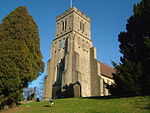Tonbridge and Malling
Boroughs in EnglandIncomplete lists from September 2019Non-metropolitan districts of KentPages with non-numeric formatnum argumentsTonbridge and Malling ... and 1 more
Use British English from June 2015

Tonbridge and Malling is a local government district with borough status in Kent, England. The council is based at Kings Hill. The borough also includes the towns of Tonbridge and Snodland along with numerous villages including Aylesford, West Malling and surrounding rural areas. The neighbouring districts are Maidstone, Tunbridge Wells, Sevenoaks, Gravesham and Medway.
Excerpt from the Wikipedia article Tonbridge and Malling (License: CC BY-SA 3.0, Authors, Images).Tonbridge and Malling
Seven Mile Lane, Tonbridge and Malling Offham
Geographical coordinates (GPS) Address Nearby Places Show on map
Geographical coordinates (GPS)
| Latitude | Longitude |
|---|---|
| N 51.283 ° | E 0.35 ° |
Address
Seven Mile Lane
Seven Mile Lane
ME18 5QY Tonbridge and Malling, Offham
England, United Kingdom
Open on Google Maps







